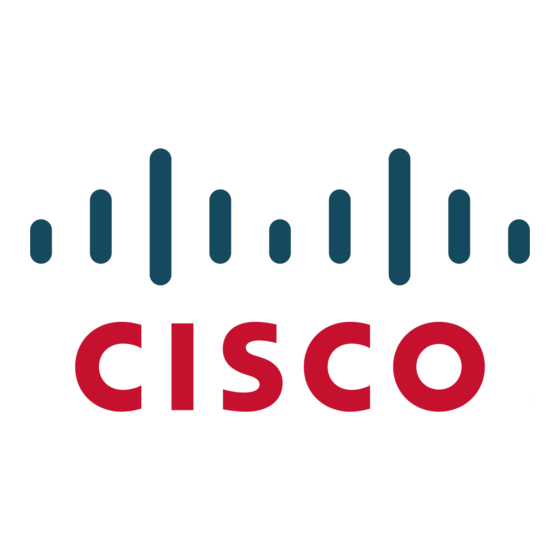Cisco 2960-24TT - Catalyst Switch Ficha de datos - Página 5
Navegue en línea o descargue pdf Ficha de datos para Interruptor Cisco 2960-24TT - Catalyst Switch. Cisco 2960-24TT - Catalyst Switch 15 páginas. Cisco catalyst 2960-24tc: specifications
También para Cisco 2960-24TT - Catalyst Switch: Ficha de datos (16 páginas), Ficha de datos (11 páginas), Boletín de productos (5 páginas), Folleto y especificaciones (10 páginas)

Table 1.
Features and Benefits of Cisco Catalyst 2960 Series
Feature
Ease of Use and Deployment
AVAILABILITY AND SCALABILITY
Superior Redundancy for
Fault Backup
Important notices, privacy statements, and trademarks of Cisco Systems, Inc. can be found on cisco.com.
Benefit
•
Express Setup simplifies initial configuration with a Web browser, eliminating the need for more complex
terminal emulation programs and CLI knowledge.
•
DHCP autoconfiguration of multiple switches through a boot server eases switch deployment.
•
Automatic QoS (Auto QoS) simplifies QoS configuration in voice-over-IP (VoIP) networks by issuing interface
and global switch commands to detect Cisco IP phones, classify traffic, and enable egress queue configuration.
•
Autosensing on each 10/100 port detects the speed of the attached device and automatically configures the port
for 10- or 100-Mbps operation, easing switch deployment in mixed 10- and 100-Mbps environments.
•
Autonegotiating on all ports automatically selects half- or full-duplex transmission mode to optimize bandwidth.
•
Dynamic Trunking Protocol (DTP) helps enable dynamic trunk configuration across all switch ports.
•
Port Aggregation Protocol (PAgP) automates the creation of Cisco Fast EtherChannel® groups or Gigabit
EtherChannel groups to link to another switch, router, or server.
•
Link Aggregation Control Protocol (LACP) allows the creation of Ethernet channeling with devices that conform
to IEEE 802.3ad. This feature is similar to Cisco EtherChannel technology and PAgP.
•
DHCP Server enables a convenient deployment option for the assignment of IP addresses in networks that do
not have without a dedicated DHCP server.
•
DHCP Relay allows a DHCP relay agent to broadcast DHCP requests to the network DHCP server.
•
1000BASE-SX, 1000BASE-LX/LH, 1000BASE-ZX, 1000BASE-BX, 100BASE-FX, 100BASE-LX10, 100BASE-
BX, and coarse wavelength-division multiplexing (CWDM) physical interface support through a field-replaceable
SFP module provides unprecedented flexibility in switch deployment.
•
The default configuration stored in flash memory ensures that the switch can be quickly connected to the
network and can pass traffic with minimal user intervention.
•
Automatic medium-dependent interface crossover (Auto-MDIX) automatically adjusts transmit and receive pairs
if an incorrect cable type (crossover or straight-through) is installed on a copper port.
•
Time-domain reflectometer (TDR) to diagnose and resolve cabling problems on copper ports.
•
Cisco UplinkFast and BackboneFast technologies help ensure quick failover recovery, enhancing
overall network stability and reliability.
•
IEEE 802.1w Rapid Spanning Tree Protocol provides rapid spanning-tree convergence independent of
spanning-tree timers and the benefit of distributed processing.
•
Per-VLAN Rapid Spanning Tree Plus (PVRST+) allows rapid spanning-tree reconvergence on a per-VLAN
spanning-tree basis, without requiring the implementation of spanning-tree instances.
•
Command-switch redundancy enabled in Cisco Network Assistant software allows designation of a backup
command switch that takes over if the primary command switch fails.
•
Unidirectional Link Detection Protocol (UDLD) and Aggressive UDLD allow unidirectional links to be detected
and disabled to avoid problems such as spanning-tree loops.
•
Switch port autorecovery (errdisable) automatically attempts to re-enable a link that is disabled because of
a network error.
•
Cisco Redundant Power System 675 (RPS 675) support provides superior internal power-source redundancy for
up to six Cisco networking devices, resulting in improved fault tolerance and network uptime.
•
Bandwidth aggregation up to 8 Gbps through Cisco Gigabit EtherChannel technology and up to 800 Mbps
through Cisco Fast EtherChannel technology enhances fault tolerance and offers higher-speed aggregated
bandwidth between switches and to routers and individual servers.
© 2005 Cisco Systems, Inc. All rights reserved.
Page 5 of 15
